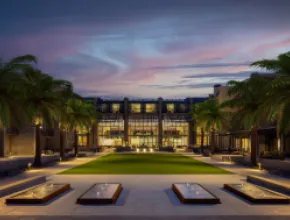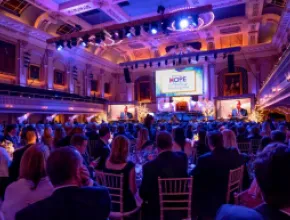There are basically two types of people who visit the Caribbean and the Mexican Caribbean: those who simply yearn for a sandy beach and a strong sun to beat down on the tiny umbrella shading their pina colada, and those ambitious explorers looking to soak up a diverse palette of cultures stretching back over centuries shaped by indigenous tribes, European colonists, marauding pirates, and countless other influences.
But whether attendees are channeling their inner Magellan or their inner Jimmy Buffett, it’s a good idea to add a dash of culture to their helping of sun and sand, or even make cultural exploration the main theme of off-site excursions.
“There are activities and itineraries that planners can take advantage of to offer attendees something really unique, something unusual, something different when they go to another country—which, of course, is one of the reasons you visit another country in the first place,” says Fernando Cervantes, director of meetings and conventions for the Cancun CVB.
Indeed, the cultural offerings in the Caribbean are so vast—encompassing everything from ancient culture to popular culture and laced with different customs, cuisines and celebrations—that a little background information upfront might give a clearer picture of how your group can segue from corporate culture to cultural enrichment when the meeting is set somewhere within the lands and islands bordering the Caribbean Sea.
First Period
Beyond the beaches and the sumptuous resorts, high-tech meeting facilities and wireless Internet service are the antiquities of the Caribbean, vestiges of ancient cultures that live on in archaeology, festivals, foods, and long-standing traditions. In the Dominican Republic, for example, culinary customs of the ancient Taino Indians are still represented in modern seafood dishes and in the fruits and vegetables, including the popular cassava, served in local restaurants.
Prominent throughout the Caribbean (though called the Lucayans in the Bahamas), the Tainos also left behind 2,000-year-old rock art in the Dominican Republic, and there is an indigenous ceremonial center in Ponce, Puerto Rico, among other Taino sites scattered throughout the region. In Aruba, visitors will find cave paintings left by the island’s earliest inhabitants, the Arawak Caquetios Indians from South America, dating back to 1,000 A.D.
However, another ancient culture confined itself to the Yucatan Peninsula and the northern elbow of Central America: the Mayans, whose ancient cities and temples have been reclaimed from the jungle to once again dominate a lush landscape of tropical forests and craggy seascapes along the Riviera Maya and northward toward Cancun. The Mayan Empire’s rise and fall, however, remains shrouded in mystery, an irresistible puzzle that keeps people flocking to sites like Chichen Itza, Xcaret, Tulum, Coba, and San Gervasio (on the isle of Cozumel) to discover a society that on its surface seems primitive, but remains advanced beyond modern understanding.
“It’s the heritage, not just of Mexico, but of humanity,” Cervantes says. “Chichen Itza is on par with the pyramids of Egypt; it has that kind of magnitude. What the Mayans did 2,000 years ago, a lot of people still do not know about.”
Cervantes notes that most meeting groups are eager to discover the past, with about 90 percent taking time to explore the surrounding Mayan world. Seeing Chichen Itza generally requires a full day for the round-trip, while Tulum is about 45 minutes from Cancun. If time is short, Cancun’s hotel zone has its own archaeological site, Ruinas del Rey (Ruins of the King), which date back to 200 B.C. and are thought to have been an astronomy lookout.
Colonial Chronicles
Without a doubt, European colonists changed the Caribbean forever, driving local tribes out and decimating others through disease and genocide. Yet it’s hard to imagine the Bahamas and Jamaica without cricket, rugby and English high tea, or Puerto Rico without the majestic fortress of El Morro, or the U.S. Virgin Islands without the Danish colonial architecture of Charlotte Amalie.
In some cases, European colonization even led to a change in geography. In the early 1600s, Spain and the Netherlands were in a tug-of-war over the island known today as St. Maarten/St. Martin. By the time Spain finally conceded defeat, setting its sights on Puerto Rico, the French had established a settlement on the island, and the 1648 Treaty of Concordia peacefully divided the land between the Dutch and French.
While today’s meeting groups savor the gastronomic delights of the island’s French culinary traditions, historic discoveries await at places like Fort Amsterdam, Fort Louis, the Salt Factory at Sucker Garden, and the Emilio Wilson Historical and Cultural Park, where limited group space is available in the Grand House.
In fact, the islands of the Caribbean are filled with remnants from the days when the entire area was like a gigantic chessboard for the European conquerors who tried repeatedly to out-maneuver each other in order to claim the most pieces of land. And although France and the Netherlands were in the game, snagging Aruba, Curacao and Martinique, among others, the big winners were Spain and England.
On the Spanish side, the Dominican Republic has the longest historical record (over 500 years) of any country in the Western Hemisphere and is the site of the first permanent European settlement in the Americas, with Santo Domingo as the first colonial capital. This UNESCO World Heritage Site is filled with 16th century dwellings, late medieval palaces and historic fortresses, and a walking tour here is a must for groups on the hunt for cultural enlightenment. Quite a few historic sites in the capital are available for receptions, dinners and other group events as well.
“Meeting planners will find a wealth of cultural sites and potential meeting venues to explore in the Dominican Republic, including the historic colonial zone,” notes Magaly Toribio, vice minister of tourism for the Dominican Republic.
But Old Spain isn’t the only cultural option here. Tobacco goes all the way back to the Taino Indians, and the Dominicans have made the most of it. Today, the country is the world’s No. 1 exporter of hand-rolled cigars, and cigar factories welcome groups that want to learn how the stogies are made. Attendees can also take the half-day trip from Santo Domingo to San Pedro de Macoris, a town famed for turning out Major League Baseball players, including Sammy Sosa and Alfonso Soriano.
Spain’s influence is also felt in the U.S. commonwealth of Puerto Rico, where Old San Juan, the only walled city in the Caribbean, boasts four fortresses from the Spanish colonial empire and literally takes days to completely explore. Standing on the ramparts of El Morro, looking out over blue Caribbean waters, is an experience no delegate should miss.
Meanwhile, the British left a lasting impression in the Caribbean as well, most notably in the Bahamas, which became a haven for fleeing British loyalists following the American Revolution and for years remained a Caribbean outpost of the British Empire, complete with colonial architecture, British currency and driving on the left side of the road.
The Bahamas broke away from Great Britain in 1973, but there’s still a lot of England left in this island archipelago, and groups can incorporate it into their itineraries in a variety of interesting ways. At Fort Charlotte, for instance, which overlooks the Port of Nassau, up to 1,500 can gather for themed events featuring period costumes, powdered wigs and British “Red Coats,” according to James Malcolm, executive director of group travel for the Bahamas Ministry of Tourism.
“We also have some very old colonial homes in Nassau, where you can travel back in time and have a themed dinner,” he says. “Or you can go one step further and take a day trip to Harbour Island.”
Accessible via a two-hour jet ferry ride from Nassau, Harbour Island is the original capital of the Bahamas, with a history dating back to the early 1700s, as well as a collection of homes dating back hundreds of years.
Out of Africa
One of the most compelling aspects of Bahamian culture, though, centers on Junkanoo, a style of music and dance that incorporates the island’s African heritage and is celebrated each year at Christmastime and during Junkanoo in June, when the streets of Nassau and Grand Bahama Island fill with frequent festivals featuring grand parades and brightly costumed dancers.
But Junkanoo can be included on the itinerary any time of year, according to Malcolm.
“A lot of groups will include Junkanoo as a performance in their evening functions,” he says. “Junkanoo troupes come and do what we call a ‘rush-out.’ That’s very popular in the evenings, or even sometimes at breakfast to get the group going.”
Of course, the Bahamas isn’t the only Caribbean nation with traditions harking back to Africa. When the first Europeans voyaged to the Caribbean looking for gold and other gems (which they found), they discovered agricultural riches as well, including the prized resources of salt and sugar cane, the latter also used to make rum.
Among the many sugar strongholds in the colonial Caribbean were the island of Hispaniola, Trinidad, the Virgin Islands—St. Croix alone had 54 sugar mills—and tiny St. Kitts, which was home to 68 sugar plantations at the time of the American Revolution. Sugar was but one of many crops grown and harvested by the Europeans, though it should be noted that the Europeans themselves didn’t actually do much of the work; that task fell to imported African slaves.
By the early to mid-19th century, though, emancipation was under way and former slaves went on to build new lives throughout the Caribbean, again completely transforming the region by shaking out the colonial aristocracy and infusing the islands with that unique Caribbean quality of easygoing enthusiasm, or as it’s known in Jamaica, irie.
In fact, every facet of life on the island Columbus called “the fairest mine eyes ever beheld” seems to proceed with “high emotion and peaceful vibrations,” as the Rastafarians define irie, though it wasn’t always so.
Colonized by Spain but captured by the British in the 1650s, Jamaica was producing 22 percent of the world’s sugar by the 18th century. However, a small band of former slaves defied the status quo and fled to the island’s mountainous interior, managing to fend off the British for a hundred years until they were recognized as a free nation in 1739. The Maroons—a name derived from the Spanish word for wild, cimarron—still live as a semi-autonomous nation in a handful of mountain towns. If your group visits around Jan. 6, it’s worth a trek into the mountains to attend the Accompong Maroon Festival, featuring traditional dancing, singing, feasting, and ceremonies.
There are myriad other ways to immerse yourselves in Jamaican culture, whether it’s attending one of many annual reggae festivals, sitting down to a traditional meal of ackee and saltfish with roast breadfruit, or gathering for a special event in one of the island’s stately Great Houses, the former plantation homes that dot the countryside.
Pirates of the Caribbean
Sure, they were swine. They were thieves and plunderers, and wreaked havoc everywhere they went. But say the word “pirate” in the Caribbean today, and you’re probably talking about a popular attraction, festival or historic site.
For instance, on the Dutch island of Aruba, which was once a clandestine hideaway for buccaneers who preyed on ships transporting Indian treasures back to the Old World, the ruins of an old pirate castle still stand near Bushiribana on the northeast coast.
In the Cayman Islands, Pirates Week is actually the national festival, held each November with street dancing, costumes, fireworks, and, of course, a mock “pirate invasion” from the sea.
And if you’re in Nassau, be sure to stop by Pirates of Nassau, a walk-though museum featuring the re-created pirate ship Revenge, along with dozens of other authentic swashbuckling settings. The museum also welcomes group events of up to 100 people, if ye be so inclined.
For More Info
Aruba Tourism Authority 877.278.2248 www.meetaruba.com
Bahamas Ministry of Tourism 800.BAHAMAS www.bahamas.com
Cancun CVB 011.52.998.881.2745 www.cancun.info
Caribbean Hotel Association 787.725.9139 www.caribbeanhotels.org
Cayman Islands Department of Tourism 877.4.CAYMAN www.caymanislands.ky
Cozumel Tourism Promotion Board 011.52.987.872.7585 www.islacozumel.com.mx
Dominican Republic Ministry of Tourism 888.374.6361 www.godominicanrepublic.com
Jamaica Tourist Board 800.294.7687 www.visitjamaica.com
Puerto Rico Convention Bureau 800.875.4765 www.meetpuertorico.com
Riviera Maya Tourism Board 011.52.984.206.3150 www.rivieramaya.com
St. Kitts Tourism Authority 800.582.6208 www.stkittstourism.kn
Saint Martin Tourist Office 877.956.1234 www.st-martin.org
Sint Maarten Tourist Office 800.786.2278 www.st-maarten.com
Trinidad and Tobago Ministry of Tourism 868.624.1403 www.tourism.gov.tt
U.S. Virgin Islands Dept. of Tourism 800.372.USVI www.usvitourism.vi






